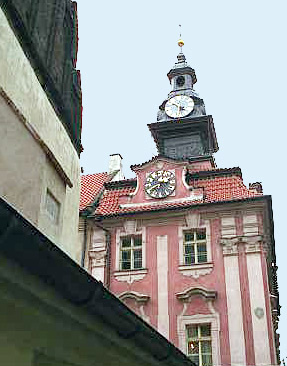History of Josefov, the old
Jewish Quarter in Prague

Hebrew Clock in Old
Jewish Quarter
One of the most popular tourist attractions
in Josefov is the Hebrew clock on the top of the Old Town Hall.
In the photograph above, the Hebrew clock is the one on the roof
just below a regular clock. The Hebrew clock has numbers in Hebrew
and runs backwards. At the bottom of the photograph, you can
see the roof top of the Old-New Synagogue. The High Synagogue
is adjacent to the Old Town Hall on the left.
In 1850, the former Jewish quarter in
Prague was incorporated into the city and was named Josefstadt
(Joseph's city) in honor of Emperor Joseph II of the Austrian
Empire which ruled over what is now the Czech Republic in the
18th century. Joseph II was an enlightened monarch who gave the
Jews in Prague their civil rights in 1781 when he issued the
Toleration Edict. This edict rescinded the old law that required
the Jews to wear distinctive caps or the yellow Star of David
on their clothing, a law which had been in effect since the 11th
century.
The edict also allowed the Jews to attend
public schools with the Christians for the first time and to
engage in occupations that had previously been forbidden. With
permission from the authorities, the Jews could now live outside
the walled ghetto, the area which is now called by the Czech
name Josefov. The gates in the ghetto wall were removed by order
of the Toleration Edict and the curfew was rescinded. The purpose
of the edict was to create a strong centralized state in which
all the people would be integrated into a single political and
economic system, instead of having the Jews as a minority group
in a separate state within a state.
Ironically, Joseph II was also the monarch
who, in 1780, ordered the construction of a military garrison
at Theresienstadt, 60 kilometers northwest of
Prague. From November 1941 until the war ended on May 8, 1945,
the Nazis used Theresienstadt (now called Terezin) as a walled
ghetto where the Jews once again had to wear the yellow star.
Theresienstadt was also used as a transit center from where the
Nazis transported 86,934 Jews to the death camps as part of their
Final Solution to the Jewish Question.
Jews had first settled in Prague in the
10th century, near the Prague castle which is just across the
Vltava river from Josefov. At the time of the First Crusade in
1096, the first recorded pogrom took place in Prague when Jews
were systematically killed by the Crusaders. This violence may
have been what prompted the Jews to move to the present Josefov
quarter of Prague, near the Old Town, in the 12th century. In
the 13th century, the Pope decreed that the Jews should be segregated
from the Christians and a wall was built around the Jewish quarter.
The Jews participated in the revolutionary
activity throughout Europe in 1848 which finally brought equal
rights for the Jews; the walls of the ghetto were torn down,
allowing the Jews to live anywhere in the city of Prague. This
caused a number of violent anti-Semitic protests by the Czechs
in Prague. With the granting of equal rights to the Jews, there
was also pressure put on them to assimilate, instead of maintaining
their separate culture. To assimilate or not to assimilate: that
was The Jewish Question. In the 19th century, The Jewish Question
was widely discussed; even Karl Marx wrote a dissertation on
the subject.
When the wealthy Jews moved out of the
former ghetto, it soon became a slum as other poor people moved
in. By 1890, the former Jewish quarter had a population of 186,000
people, but only 20% of them were Jewish. In 1893, the city decided
to completely demolish the whole Josefstadt quarter, leaving
only 6 synagogues, the old Jewish cemetery, the Ceremonial Hall
and the Old Jewish Town Hall, which are collectively known as
the Jewish Museum.
|